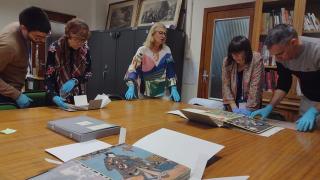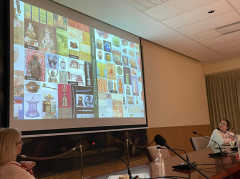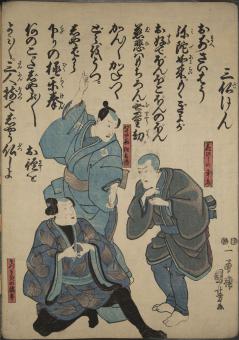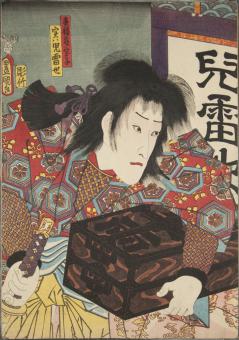-
ARC-iJAC Project Spotlights: An Interview with Dr. Pilar Cabañas (The Complutense University of Madrid, Spain) on Digital-Archiving the Complutense Library's Japanese CollectionApril 17, 2024(Wed)
Background:
The ARC-iJAC project Ukiyo-e, illustrated books, albums and painted books in Madrid Collections emerged as an initiative of Asia Research Group (GIA), attached to the Complutense University of Madrid in Spain, which has been collaborating with the Art Research Center (ARC) for about two years and thanks to which significant progress has been made in the analysis and cataloging of ukiyo-e albums and books that are part of the collections of the Complutense University Library and that have remained almost unknown and, in some cases, in a poor state of preservation.
Involved in this project have been the professors Pilar Cabañas, Matilde Arias, Aitana Merino, and Ana Trujillo with the new incorporation of the researcher Alba Finol.
Click here for the Japanese collection of the UCM:
→ARC Ukiyo-e Portal Database
→ARC Early Japanese Books Portal DatabaseCould you please tell us about your motivation and the purpose of conducting the ARC-iJAC research project on the ukiyo-e, illustrated books, and albums in Madrid collections?

What encouraged us to initiate this project was to give value to the collections of the Complutense Library. Due to a lack of resources, these books and ukiyo-e had remained uncatalogued in the university's collections.
This project has enabled us to study them in-depth and make them known, not only in the Spanish context as part of the heritage of our institution, but also internationally, since the ARC database is a platform of great diffusion for specialists in Japanese art from all over the world. We are delighted with this possibility. Moreover, thanks to this collaboration, being in a space of great specialists, we can compare our knowledge and expand it.
What is distinctive about the Madrid collections?
In Madrid, there are no large collections of Japanese art or a historical tradition of its study. In the absence of major collectors, this material is a unique example within the panorama of Spanish collecting. Through these pieces, we can study the motivations and interests of the Spanish artistic market of the time, determined by its particular historical context, both economic and cultural.
Although they are not numerous, they are interesting examples of costumes, kabuki plays, and other themes that make us wonder about how they were perceived at the time in the Spanish context. Given the importance of their authors, they also represent a re-evaluation of the heritage of Japanese art in Spain.
How has the ARC-iJAC supported you in realizing this project and which research objectives have you been able to achieve?
The collaboration with the ARC-iJAC has been fundamental in the work of cataloging these works, solving our doubts whenever we have had them, especially in the transcription of texts and in the cataloging of themes and artists, as well as in certain specificities related to the art history of Japanese antique books and ukiyo-e.
You have recently launched an online exhibition on shini-e. Can you tell us more about it?
The virtual exhibition of SHINI-E, hosted on the website of the Complutense Library of Madrid, was an initiative on our part to publicize our project. We decided to focus on a specific aspect of the collection that would be attractive to users, and it seemed to us that the shini-e genre was little known to the general public.
The preparation of this exhibition involved presenting the public with specific information, not only about shini-e but also about more general aspects related to shini-e. Some of the merits achieved have been the opportunity to study specific aspects of each print - not only technical data collected in the print;something that already appears in the ARC database -but also information about the characters depicted.The transcription of the texts that appear in the images is perhaps the most valuable information obtained through this process. This allowed us to translate them into Spanish, including linguistic decisions that we understand will be useful for future students and researchers of the collection.
Likewise, the presentation is made in a way intended to be clear, and useful, even for those uninitiated in the Japanese language. Another specific aspect is that each image shown is accompanied by a link that directs the user to the ARC database to access detailed information that appears in neither the interface of the Complutense Library collection nor in the virtual exhibition. In these cards, we have tried to include texts in English to facilitate communication with those users who are not familiar with either the Japanese or Spanish languages, although these are isolated cases and not the entire collection.
How do you feel about the execution of the ARC-iJAC project? Have you come across any particular challenges?
Thanks to the implementation of this project, detailed cataloging of part of the library's holdings has been carried out. This research has led to new discoveries within the collection itself, such as the existence of poems, characters, and kabuki plays not yet studied in the Spanish scene. It has also meant a clear dissemination of information that has generated interest among the general public and students of Japanese art. All this makes clear the importance of the ARC database as a working tool for researchers who want to specialize in Japanese prints.
As for the challenges, although the albums were already digitized, when we checked the original material we could see that some of the albums were in a poor state of conservation, discolored, and out of order. The lack of institutional funds for the project also contributed to the limitations in achieving and meeting deadlines.
How did you first connect with the Art Research Center (ARC) at Ritsumeikan University? How did you hear about the International Joint Digital Archiving Center for Japanese Art and Culture (ARC-iJAC)?
It was through the collaboration scholarships offered on their web page. It seemed like just what we were looking for. In addition, the database is also well-known among specialists in Japanese art in Spain, so we were delighted to have been able to collaborate with the ARC-iJAC.

In our experience, collaboration with Japanese institutions has always been great. We have always learned a lot from them, and this was no exception.
Is there anything else you would like to comment on or highlight, for example, regarding the direction of future collaboration?
It is an honor for us to be part of this immense project, considering our small contribution. We are excited and look forward to moving forward in the future.
Activities carried out as a result of the collaboration with the ARC-iJAC during FY 2023:
- Virtual exhibition of SHINI-E, hosted on the website of the Complutense Library of Madrid, was an initiative on our part to publicize our project. Focused on the shini-e genre. (https://patrimoniodigital.ucm.es/s/shinie-en/page/welcome)
- Complu-Asia Seminar: Museums in Asia. With two lectures on: digital archives // our collaboration with the ARC-iJAC (https://f965c820-9ad9-444b-8c5c-fbd24bc1b6fb.filesusr.com/ugd/c52cf2_d87c32a19d334acfa7183dd43c82d393.pdf)
- Revista de museología: Spanish publication with upcoming issue dedicated to Japanese art collections and museums both in Japan and internationally, again paying special attention to the digital humanities (https://www.museologia.net/)
- International Joint Digital Archiving Center for Japanese Art and Culture (ARC-iJAC) & "Digital Humanities Center for Japanese Arts and Cultures"-Project, Art Research Center, Ritsumeikan University FY2023 Annual Report Meeting: "Ukiyo-e, illustrated books, albums and painted books in Madrid Collections" conference (Aitana Merino)















